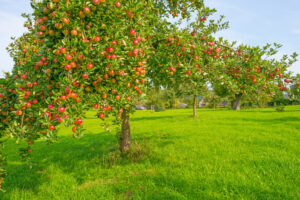Introduction
Overview of Zone 8
Zone 8 fruit trees are many. Zone 8 is a unique geographical segment that experiences a moderate climate, characterized by hot summers and mild winters. This zone’s average minimum winter temperature ranges between 10 to 20 degrees Fahrenheit, making it an ideal environment for a great variety of fruit trees, bushes, and vines. The prolonged growing season in this zone allows for successful cultivation of a wide range of fruits from apple and peach trees to blueberry bushes and grapevines.
Common Fruit Trees, Bushes, and Vines in Zone 8
Among fruit trees, apples, peaches, and pears thrive in Zone 8, with varieties such as the ‘Red Delicious’ apple, ‘Elberta’ peach, and ‘Bartlett’ pear being particularly well-suited to the region’s climate. Citrus fruits like oranges, lemons, and grapefruits can also be successfully grown here, thanks to the mild winters but will need frost protection.
Zone 8 Fruit Trees
Cherry Trees
Cherry trees are another popular fruit tree in Zone 8 due to their cold-hardy nature and the attractive blossoms they bear in spring. Varieties such as ‘Bing’ and ‘Rainier’ are commonly grown and cherished for their sweet, juicy fruits.
Olive Trees
Olive trees, while not a traditional fruit tree, are quite prevalent in Zone 8 because of their love for warm climates. These trees not only yield olives that can be used for oil extraction or direct consumption but also lend a distinctive Mediterranean allure to landscapes.
Fig Trees
Fig trees thrive in the Zone 8 climate, providing bountiful harvests of sweet and nutritious figs. The ‘Brown Turkey’ and ‘Celeste’ varieties adapt well to the region’s conditions, making them ideal choices for local cultivation.
Persimmon Trees
Persimmon trees, especially the ‘Fuyu’ and ‘Hachiya’ varieties, flourish in Zone 8. These trees are appreciated for their vibrant autumn foliage and sweet, unique fruits which are enjoyed fresh or used in culinary applications.
Apple Trees
Apple trees are a staple in many gardens and orchards across Zone 8, with popular varieties such as ‘Gala,’ ‘Granny Smith,’ and ‘McIntosh.’ These trees require a certain number of chill hours to produce fruit, making them well-suited to the region’s mild winters.
Peach Trees
Peach trees thrive in Zone 8, producing large, juicy fruits that are perfect for eating fresh or using in recipes. Popular varieties such as ‘Elberta’ and ‘Hale Haven’ are well-adapted to the region’s climate and provide excellent yields.
Citrus Trees
Citrus trees like oranges, lemons, and grapefruits can also be successfully grown in Zone 8 thanks to the area’s mild winters. These trees require a lot of sun and well-draining soil to thrive, making them perfect for planting in sunny spots in the garden.
Zone 8 Fruit Tree Care
Care Instructions for Fruit Trees in Zone 8
Cherry Trees
Cherry trees in Zone 8 require regular watering until well established, followed by deep watering during dry periods. They prefer full sun and well-drained soil. Prune annually for shape and to remove dead or diseased wood.
Olive Trees
Olive trees need plenty of sunlight and well-drained soil. They are drought-tolerant once established but benefit from occasional deep watering during dry periods. Prune lightly in early spring to maintain shape and promote robust growth.
Fig Trees
Fig trees thrive in full sun and prefer well-drained soil. Water them regularly during dry spells. Prune lightly during the dormant season to maintain shape and promote new growth. Protect young trees from frost with burlap or frost cloth.
Persimmon Trees
Persimmon trees need full sun and well-drained soil. Water deeply but infrequently, allowing the soil to dry between waterings. Prune minimally, only to remove dead or diseased wood. Young trees may need protection from frost.
Remember, each variety may have its own specific care requirements, so it’s best to research and consult with local nurseries or extension services for the most accurate and timely advice.
Apple Trees
Apple trees in Zone 8 require full sun and well-drained soil. They need regular watering until established, and deep watering during dry spells. Prune annually for shape and to remove dead or diseased wood.
Peach Trees
Peach trees thrive in full sun and need well-drained soil. They require regular watering until established, followed by deep watering during dry spells. Prune annually in late winter to promote new growth and remove dead or diseased wood.
Citrus Trees
Citrus trees, such as oranges, lemons, and limes, need full sun and well-drained soil. They are drought-tolerant but require regular watering until established. Prune lightly in late winter to maintain shape and remove dead or damaged branches.
Remember to provide appropriate support for your fruit trees with stakes or trellises if needed. Proper care and maintenance will ensure a bountiful harvest and healthy trees for years to come.
Zone 8 Bushes
Blueberry Bushes
Blueberry bushes, such as the ‘Tifblue’ and ‘Powderblue’ varieties, are well-suited to Zone 8. They require full to partial sun and acidic, well-draining soil. Water them regularly, ensuring the soil is consistently moist but not waterlogged. Prune annually during early spring to encourage new growth and fruit production.
Raspberry Bushes
Raspberry bushes can tolerate the climate in Zone 8. These bushes need full sun and rich, well-drained soil. Water deeply once a week and more frequently during dry periods. Annual pruning in early spring is beneficial to promote new growth and fruit yield. You prune out the old canes that have already produced fruit and keep the new canes for next year’s crop.
Blackberry Bushes
Blackberry bushes thrive in Zone 8, especially varieties like ‘Arapaho’ and ‘Navaho.’ They prefer full sun and well-drained soil. Water consistently and thoroughly, especially during fruiting. Prune old canes after harvest to encourage new, productive growth.
Gooseberry Bushes
Gooseberry bushes, including the ‘Invicta’ variety, do well in Zone 8. They need full sun to light shade and well-drained soil. Water regularly and increase watering during dry periods. Prune lightly in late winter to maintain shape and promote new growth.
As with fruit trees, the specifics of care can vary between different varieties of fruit bushes. Be sure to research individual requirements for the best results. Regular care, including watering, pruning, and protection from pests and disease, will ensure healthy, productive bushes.
Zone 8 Vines
Grape Vines
Grape vines, particularly varieties like ‘Thompson Seedless’ and ‘Concord’ flourish in Zone 8. They require full sun and well-drained soil. Water them regularly, ensuring the soil is consistently moist but not waterlogged. Prune annually during late winter to encourage new growth and fruit production.
Passionfruit Vines
Passionfruit vines are well-suited to the conditions in Zone 8. These vines thrive in full sun and rich, well-drained soil. They need deep watering once a week with more frequent watering during hot and dry periods. Prune in early spring to stimulate new growth and larger yield.
Kiwi Vines
Kiwi vines, especially varieties like ‘Hayward’ and ‘Bruno,’ do well in Zone 8. They need a sunny location and well-drained soil. Water regularly, particularly during dry spells. Prune in late winter to promote new, productive growth.
Remember, the specifics of care can vary between different varieties of fruit vines. Always research the individual requirements for each type. Regular care, including watering, pruning, and protection from pests and disease, will ensure healthy, productive vines.
Pests in Zone 8
Common Pests and Their Control in Zone 8
Aphids
Aphids are small, soft-bodied insects that can be problematic for fruit trees, bushes, and vines. They suck sap from plants, subsequently causing leaves to curl and yellow. Regularly monitor your plants for aphids, and if detected, use insecticidal soaps or introduce natural predators like ladybugs.
Scale Insects
Scale insects attach themselves to stems, leaves, and fruit, causing wilting and yellowing. They can be managed by pruning infested branches and using horticultural oil sprays during the dormant period.
Codling Moths
Codling moths, particularly prevalent in apple and pear trees, tunnel into fruit causing significant damage. To control them, use pheromone traps to disrupt mating and introduce beneficial insects that prey on the moths.
Japanese Beetles
Japanese beetles feed on leaves, flowers, and fruits. Hand-picking can be effective for small infestations while applying neem oil or introducing natural predators can help for larger infestations.
Always remember, prevention is better than cure. Regular inspections, proper sanitation, and maintaining a balanced ecosystem with natural predators can go a long way in keeping these pests at bay. Pesticides should be a last resort due to their impact on non-target species and the environment.
Overall Care and Maintenance
Regular care of fruit plants in Zone 8 involves a balance of watering, feeding, and pruning. Given the moderate climate of this zone, watering should be consistent but not excessive, ensuring the soil is moist but well-drained. Mulching can be beneficial in maintaining soil moisture levels and preventing weed growth. Regular feeding with a balanced fertilizer is essential during the growing season to support fruit development and overall plant health.
Pruning is a crucial aspect of fruit plant care in Zone 8. It is best performed during late winter or early spring when most plants are dormant, to promote new growth and increase fruit production. Make sure to remove dead or diseased wood, and thin out crowded branches to improve air circulation and sunlight penetration, which can help in preventing diseases.
Special considerations for Zone 8 include the risk of late frosts, which can damage new growth and blossoms in spring. Protective measures such as frost blankets or temporary covers can be used when frost is forecasted. Additionally, in the heat of summer, some plants may require additional watering and protection from extreme sunlight. Heat-tolerant varieties are often a good choice for Zone 8 to ensure a successful and productive fruit garden.
Conclusion
To summarize, successful fruit gardening in Zone 8 involves careful consideration of plant selection, pest management, and ongoing care and maintenance. Selecting fruits suited to the moderate climate of Zone 8 is critical, as is cultivating a balanced ecosystem that naturally deters pests. Regular watering, feeding, and pruning are essential aspects of care, with special considerations needed for potential late frosts and extreme summer heat.
In conclusion, while there are challenges to be met, with careful planning and diligent care, a fruitful and vibrant garden is entirely achievable in Zone 8. Remember to be patient and persistent, as gardening is a journey of learning and growth, both for the plants and the gardener. Enjoy the process, and the fruits of your labor will be all the more rewarding!


